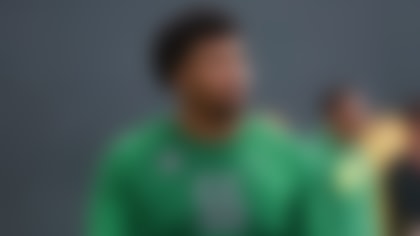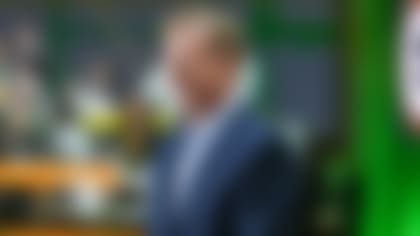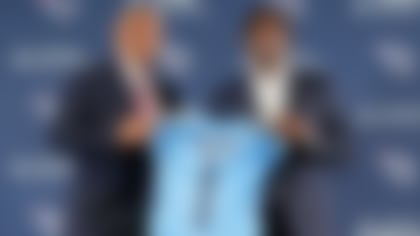In a world of do-it-yourself mock drafts and year-round coverage of the NFL draft, the determination of where college football players will start their professional careers becomes trivialized.
Reuter: Let's make a deal
Chad Reuter explores potential draft-day trades for hot commodities like Ryan Tannehill, Justin Blackmon and Michael Floyd. **More ...**
But make no mistake, the decisions teams make are extremely difficult -- and expensive. Not only are multi-million dollar rookie contracts awarded to these players, but the vocational fate of coaching staffs and front office personnel will eventually be determined by the choices made in draft rooms in April.
At times, only the slightest difference separates prospects at the same position. This is the case at the two highest-profile positions in this year's draft: quarterback and wide receiver. The success and talent of passers Andrew Luck (Stanford) and Robert Griffin III (Baylor) and pass catchers Justin Blackmon (Oklahoma State) and Michael Floyd (Notre Dame) have caused many sleepless nights in some NFL cities.
History tells us that when two prospects at the same position are selected in close proximity to each other near the top of the draft, one of them will fall short of expectations due to inconsistent play, a lack of surrounding talent or a bevy of other reasons. The pre-draft debates surrounding quarterbacks Peyton Manning and Ryan Leaf in 1998 and receivers Charles Rogers and Andre Johnson in 2003, for example, have certainly played out in the Colts' and Texans' favor, respectively.
Two similar debates about the top quarterback and receiver in the 2012 class are occurring in team facilities right now. Here's one take on who is most likely to be the better pro ...
Quarterbacks: The Natural vs. Mr. Excitement
Throughout the fall, it was assumed that whichever team ended up with the No. 1 pick would select Luck. From the moment he took the field in Palo Alto, it was clear the son of former Houston Oilers quarterback (and current West Virginia athletic director) Oliver Luck had the genetic makeup to become an NFL starter.
But as the season progressed, RG3 took his game to the next level, becoming the first Heisman Trophy winner in Baylor history. In fact, he was so impressive on tape and at the NFL Scouting Combine that the St. Louis Rams leveraged two future first-round picks and this year's No. 39 selection from the Washington Redskins in exchange for dropping just four spots (from No. 2 to 6) in this year's first round. Griffin was known to be a sensational athlete throughout his Baylor career, even earning All-America honors on the Baylor track team for his work in the 400-meter hurdles. But his strong arm, accuracy and touch on deep passes from the pocket opened the eyes of teams that previously thought he was more athlete than quarterback.
But Luck still rates higher than Griffin among scouts for a couple of reasons. First, he is a very good athlete himself -- so Griffin's mobility is not as big as difference as you'd expect against the taller, thicker Luck. Also, Luck's ability to call plays and make adjustments at the line of scrimmage in a pro-style system shows teams he already can handle those responsibilities at the next level. Luck's arm strength is more than sufficient to make every NFL throw, and his accuracy throwing on the run to his left and right means his offensive coordinator can utilize his entire playbook.
Although Griffin's athleticism is unquestioned and he did make plays from inside the pocket, he also took a lot more sacks than Luck in 2011 (Stanford allowed 11 against Baylor's 29). The Cardinal have more pro prospects on the offensive line than the Bears, to be sure, but Luck's superior pocket poise did not escape the notice of NFL general managers.
Darlington: Win-win situation
Washington's sitting pretty with the No. 2 pick. As Jeff Darlington reports, the 'Skins know they're getting a franchise QB. **More ...**
Some scouts will wonder how many shots Griffin can take from NFL defenders as he uses his escapability and speed in the open field to move the chains. He missed all but three games of the 2009 season with an ACL tear in his right knee, opening the door for some durability concerns. Toughness, however, won't be an issue; he finished out the first half against Northwestern State after suffering that knee injury as a sophomore, throwing for 226 yards and three touchdowns.
Both these players have the talent and character to lead an NFL team to regular playoff appearances, so it is definitely possible they could buck the 50-50 success trend for this position at the top of the draft. And a quarterback's coaching and surrounding talent are major -- and unpredictable -- factors in their NFL success.
But NFL Commissioner Roger Goodell is expected to read Luck as the Colts' pick to open the proceedings at Radio City Music Hall because he is the odds-on favorite to enjoy the superior career.
Wide receivers: Splitting hairs at split end
Blackmon hauled in two Biletnikoff Awards as college football's top wide receiver while piling up more than 3,300 yards and scoring 38 touchdowns in 2010 and '11 -- numbers not often seen, even in today's era of prolific spread offenses.
Though Floyd's production pales in comparison during that span (2,172 yards, 21 touchdowns), who knows what his numbers would have been if he'd caught passes from solid quarterback prospect Brandon Weeden in the Cowboys' wide-open system instead of being on the other end of uneven play from young Irish quarterbacks the past two seasons?
The similarities between the two receivers are much greater than the differences. Both are physical receivers capable of beating press coverage from smaller cornerbacks and making acrobatic catches on the sideline against man coverage. They will also assist running backs with strong blocking on the outside, though Floyd is more consistent in this area. Not only were both likely top-15 picks targeted on vertical routes, but also short crosses and bubble screens to get the ball into their hands to make a play.
Both posted similar 40-yard-dash times in the mid-to-high 4.4-second range, but the overall tale of the tape is slightly in Floyd's favor: He beats Blackmon in height (6-foot-2 vs. 6-0), weight (220 pounds vs. 215), arm length (32 7/8 inches vs. 32 1/2) and hand size (9 3/8 inches vs. 9 1/4).
The main difference between the two receivers might be what scouts term "suddenness." Floyd struggles a bit more trying to get into and out of breaks cleanly, while Blackmon's smoother routes and quicker short-area foot quickness will help him get open more consistently at the next level. Blackmon also seems to have a bit more agility in the open field, whether trying to separate from cornerbacks with or without the ball. (Neither he nor Floyd is exceptional in that area, however -- both rely on strength, rather than pure speed and quickness to avoid tacklers.)
Brandt: The Hot 100
How did the various pro days impact the draft? Gil Brandt updates his top 100 prospects, and there's a surprise at WR. **More ...**
Another important point in this discussion is off-field conduct. Floyd's alcohol-related issues have been well-documented, but people forget Blackmon was also arrested for driving under the influence coming back from a Dallas Cowboys game in October of 2010. If Blackmon's overall work ethic and character grades are superior to Floyd's, however, the choice between the two becomes easier.
Teams are not likely to consider either Blackmon or Floyd truly elite receivers with the ridiculous size/speed combination of Detroit Lions beast Calvin Johnson or the hands of Arizona Cardinals star Larry Fitzgerald. But if forced to pick one to become a Pro Bowl regular over the next few seasons, Blackmon gets my vote.
Follow Chad Reuter on Twitter @ChadReuter




